In this silent film, a runaway orphan forms a partnership with a junk dealer on the Lower East Side, curing the old man of his loneliness and helping him find his due fortune. Directed by Buster Keaton’s former collaborator, Edward F. Cline, this comedy-drama stars an 11-year-old Jackie Coogan, who had recently gained fame from Charlie Chaplin’s acclaimed film, The Kid. Also in Rag Man is the largely-forgotten Jewish comic actor, Max Davidson, and a raucous horse named ‘Dynamite.’
The Rag Man is noteworthy for being one of the earliest feature-length films to shoot extensively on the streets of New York. But surprisingly enough, it’s not very well-known today —even among film historians— despite the fact it starred little Jackie, one of Hollywood’s biggest child actors of the time.
Kelly Cuts Pants
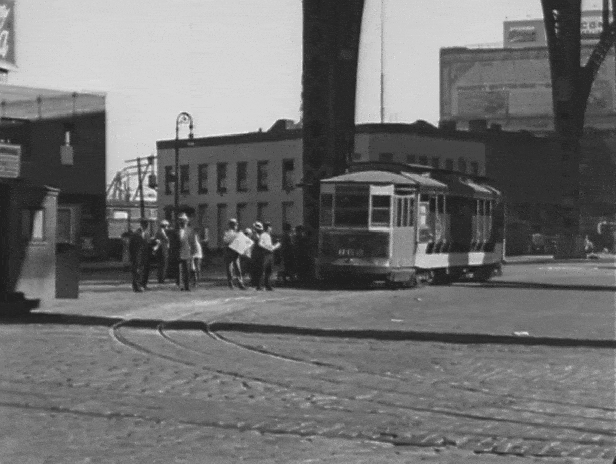

Finding this location was a fairly simple task, since the scene features the unmistakable steel substructure of the Riverside Drive Viaduct, which runs above 12th Avenue in Upper Manhattan.
In order to find the exact spot, I just went to Google Street View to examine 12th Avenue. Starting at the south end of the viaduct, I almost immediately found a matching building at no. 2284. It’s actually quite lucky that the building is still around (most likely because it houses the popular Fairway Supermarket), since a lot of the original buildings along 12th Ave. have been demolished. So, by using this extant building as a marker, I was able to determine that the shot of the streetcar took place on 125th Street.
Assuming the shot of Kelly laying down his pants was nearby, I quickly gleaned the location, based on the slight hill seen in the background on the left. I knew that there was a street at the end of 12th Avenue that went up a hill and connected with Riverside Drive above, so once I pinpointed that street, I was able to deduce that the pants were placed on St. Clair. This spot makes geographical sense because you can see in the previous shot that the streetcar tracks start to curve to the east one block south of 125th Street.
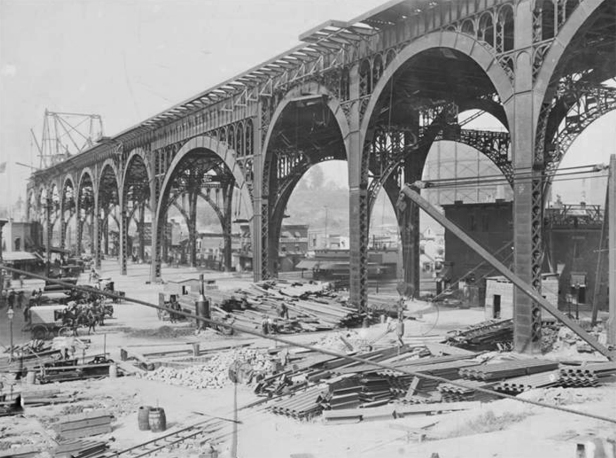
Erected in 1900, the Riverside Drive Viaduct, which carries Riverside Drive 80 feet above 12th Avenue (called Manhattan Avenue at the time), was considered to be a great feat of engineering, but also had its share of critics. An 1897 article in the New York Times voiced its concern, suggesting that the proposed viaduct could cause a “grievous and irreparable” injury to the city:
The public hearing given by the Board of Street Openings and Improvements yesterday developed vigorous and righteous opposition to the plans of the Department of Public Works for the extension of Riverside Drive across the Manhattan Valley. The plan is just the sort of scheme the public would expect from the official who proposed to convert the lower end of Central Park into a desert of asphalt.
What New York has a right to expect is a substantial and dignified structure which shall be worth looking at on its own account, and which shall not disfigure the drive, the great monument that is already built, or any others that may be built hereafter.
Unless and until we can afford to do this work in a fitting way, we cannot afford to do it at all. The notion of throwing across the valley, north of Grant’s tomb, another such unsightly lattice-work as now skirts the northwest corner of Central Park should not be thought of for a moment.
Opinions like these most likely influenced the designers to focus on both form and function when conceiving the Riverside Drive Viaduct, making it more than a utilitarian structure, but something that could be considered artistic.
Criticisms aside, the use of steel in the viaduct’s construction was unique for the time —as similar elevated structures in the past relied more heavily on stone and iron— and upon its completion, it was considered a success in engineering.
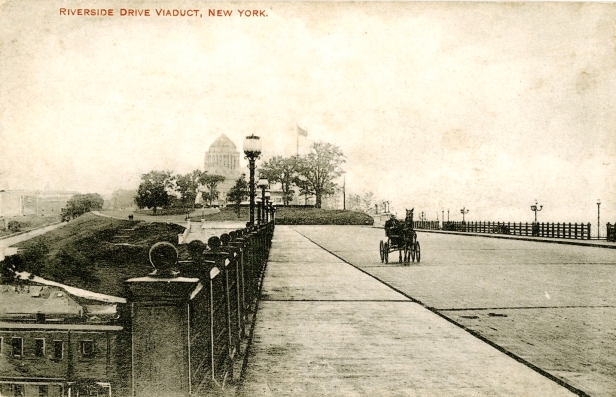
And yet, as advanced as the design was in 1900, by the mid-1980’s, many of the city’s elements —salt, pollutants and corrosives in the air, as well as the byproducts of countless pigeons— took their toll on the viaduct, making it unsafe to travel on. In the end, the state spent millions of dollars replacing most of the girders, crossbeams, and lattice work.
Today, the Riverside Drive Viaduct comprises of almost entirely new parts, but remains a symbol of America’s late 19th-century “City Beautiful” movement, where urban planners tried to emphasize the beautification and monumental grandeur of large cities. Whenever I bike across this elevated highway, I’m amazed how little traffic there usually is, considering that it’s a much more pleasant and picturesque way to travel on the Upper West Side.

Finding the location of the last shot from this scene was pretty easy, due to the 59th Street Bridge being present in the background. It didn’t take long to conclude that the action took place on Sutton Place a block or two south of 59th Street. And finding the exact street corner was equally easy since the block of Federal style buildings seen across the street are still around today (which was rather fortuitous since almost all of the other townhouses that were on Sutton in 1925 have since been demolished).
However, when it came to the first part of this scene where the two characters first meet, I had a comically difficult time trying to find its location. Part of this difficulty came from me assuming it was shot at a completely different New York location.
I already knew the filmmakers weren’t adhering to strict geographical accuracy, since the previous “Kelly Cuts Pants” scene was shot on the other side of Manhattan, even though it was supposed to take place in the same area as this “Meet” scene. So, I figured there could’ve been multiple locations used within this scene as well.
Naturally, I first needed to investigate the Sutton Place area near the 59th Street Bridge since that was already established. In one intermediate wide shot where Kelly chases Max’s carriage, I thought the landscape looked similar to Sutton —namely, a street with a slight decline that appeared to dead-end at an open body of water— but I also knew it could’ve been filmed at any number of other locations.

The most obvious clue I had to go on was what appeared to be a Burns Bros Coal building in the background. The signage on the outside read, “50 Church Street,” but since the building was clearly not on Church (which was an inland street in a largely built-up neighborhood), I figured it was simply a notice of their flagship location. However, I was also aware that it could’ve simply been an advertisement on a building that had nothing to do with the coal company. Either way, since Burns Bros Coal was the only apparent landmark in that shot, I had to start there.
Knowing this would be a daunting task, I enlisted the help of Blakeslee, my research partner, who shortly discovered that Burns Bros had a yard on W 135th Street near the Hudson River. This gave me a glimmer of hope, since it was only a few blocks away from the location of “Kelly Cuts Pants” scene. However, after looking at vintage photos from the area, it was becoming clear that the coal yard on W 135th Street couldn’t be the same one from the scene. (If it was actually filmed up along the Hudson River near 135th, the West Harlem viaduct would have been visible in several of the shots, but it’s clearly absent in this scene.)
So, we continued researching Burns Bros Coal and looking through hundreds of vintage photos along the East and Hudson Rivers, trying to find a matching building. During this search, I would occasionally come across a thumbnail picture that featured a structure with COAL written on it, which would give me a momentary jolt of excitement. But after expanding the photo to full-view, it would never end up being the one in the film. (It didn’t occur to me at the time how commonplace coal companies were back in the early 20th century (much like Starbucks or Citibank is today). So, the search continued.

One nice byproduct that comes with researching these old movie locations is stumbling upon interesting historical tidbits about old New York. In the case with this movie, I discovered a story about George Burns (born Nathan Birnbaum), who supposedly got his stage name from the Burns Bros Coal Company.
As the story goes, while growing up on the Lower East Side, he and his brother would often steal pieces of coal off of the Burn Bros trucks as they went through their neighborhood and stuff them in their pockets. When they returned home, neighbors would jokingly call them “the Burns Brothers,” — a surname George would later adopt when getting into show business. Granted, this could be one of those typical apocryphal Hollywood origin-stories that were common back in the day, but I think it kind of rings true.
Regardless, the George Burns/Burns Bros connection didn’t get me any closer to finding the filming location from this scene. So, the next step was to go to the 42nd Street Library and look up “Burns Bros Coal” in the 1924-25 Manhattan phone directory, hoping it would list some of its addresses.

Earlier, Blakeslee had found an abridged list of Burn Bros locations online, but the phone directory definitely had more locations, many of which were on a river. But after investigating all the addresses, we concluded none of them were the one from in the film. So once again, we were back to square one.
Right around this time, we were starting to become disillusioned that we’d ever be able to find this location, especially since we knew that most of the buildings that were in a waterfront area in 1925 would probably be long-gone today. But the one last thing that intrigued us about the scene was a somewhat unique-looking structure that was located behind the coal building, which I assumed was a pier that extended into the water.
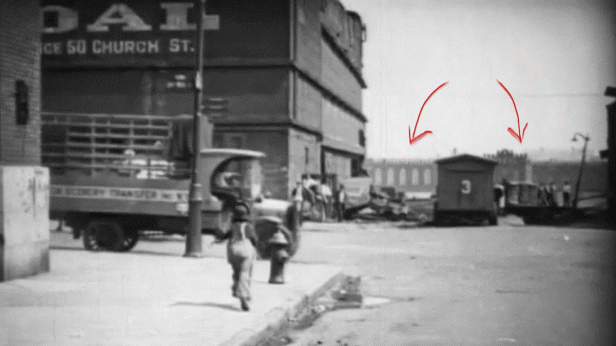
Blakeslee had another idea. On a hunch, he did some investigating into a former prison that was located on Roosevelt Island (known as Welfare Island at the time). After a little bit of digging, he found a photo of the penitentiary, and it looked like it could be a match.

With this new information in hand, we immediately went to the vintage maps to study the area directly across from Roosevelt/Welfare Island, which turned out to be… Sutton Place! And lo and behold, a 1930 map of that area showed something wonderful:

Yes! At the end of 56th Street, along Sutton Place (called Avenue A at the time) was a building labeled, “Burns Bros Coal Co.” This meant that the scene where Max and Kelly first meet took place at the corner of 56th and Sutton, and the bit where Kelly chases him would have been up along Sutton, ending on the corner of 57th Street near the 59th Street Bridge — the very same spot I identified three weeks prior.
To further confirm this location, I searched a bunch of online digital archives for any photos of that area. Sadly, I still couldn’t find a picture of that Burns building, but I did find a 1928 photo on the NYPL website that featured a sign from Sutton Place Garage that matched a sign from inis scene.
And with that, I was certain we found the right place. Turns out, this sequence was completely geographically accurate.

So, the lesson learned is that I should’ve trusted my first instinct and made sure to absolutely exclude Sutton as a possibility before moving on. If I had simply gone to a vintage map, I would’ve seen the building marked “Burns” and three weeks of research could have been saved… although, I might have never found out how George Burns got his name from a coal company.
UPDATE: About a year after posting this entry, the NYC Municipal Archives released all their 1940s tax photos online, and I have since found some more evidence to support our findings.

However, even with their treasure-trove of incredible archive images, the Municipal website still didn’t have a photograph of that damn coal building. I guess it’s possibly just one of those unique NYC spots that was only captured in a single, relatively-unknown silent film.
Driving Through the Wall Street District

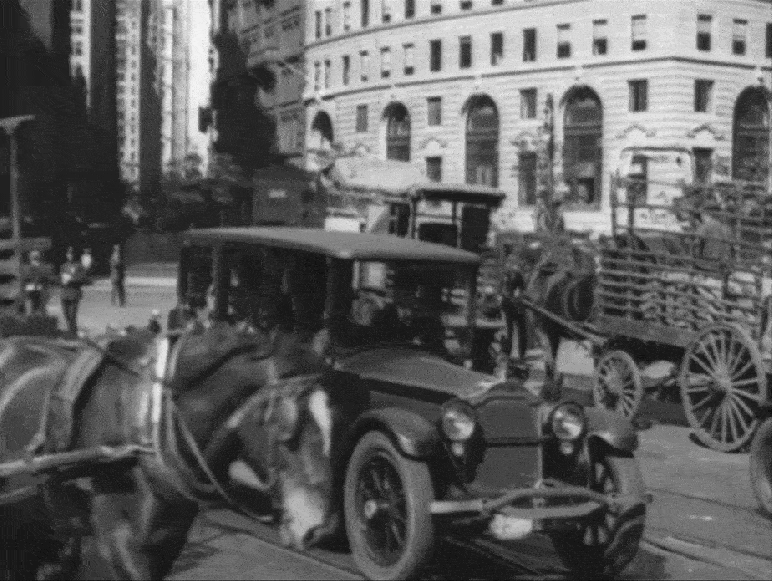
This was probably the easiest location to identify from this movie. Even though the title card says, “The Wall Street District,” I immediately recognized Bowling Green in the background and knew they were at the southern end of Broadway, with the camera pointing north..
Kelly Sells Junk




The first shot in this sequence was easy to find, since it included a clear close-up shot of the Fifth Avenue street sign. But the part where Kelly goes to the mansion, things got a little tough.
The Kelly character actually visits the mansion twice in the film, and each time it’s preceded with a quick establishing scene that was easily identifiable. The first time he goes to the mansion, it’s preceded with a shot of him at Fifth Avenue and E 63rd, and second time it’s preceded with a shot of him exiting a subway at Fifth Avenue and E 60th. (See “Exiting the Subway” below.) Therefore, a good place to start was the Upper East Side, somewhere near Fifth Avenue.
The scene obviously wasn’t taking place on Fifth itself (otherwise, Central Park would’ve been visible), so I began investigating the avenues directly to the east, hoping I could get lucky and locate a building that matched one of ones in the film. But after searching the area in Google Street View, I couldn’t find anything, which didn’t exactly surprise me. Even though a lot of the buildings on the Upper East Side are from the early 20th century, I had suspected that the two most distinct-looking buildings from the scene —the mansion Kelly visits and the mansion across the street— were most likely demolished.
But then I focused on one big clue in the wide shot of Kelly getting back into his carriage that could help narrow the search — in the far background, you cans see what looks like a short train traveling along an elevated track. Assuming we were still on the Upper East Side, that would mean that that elevated track was most likely the Third Avenue El. And if that was the case, then that would mean the camera wasn’t looking north or south, it was looking east towards Third Avenue. And from that, I could pretty much surmise that the scene took place somewhere along Madison Avenue, since Park Avenue would’ve had a telltale median strip running along it and Lexington Avenue would’ve been too close to Third.
The next step was to start searching through the NYPL Digital Archives for any vintage photos in on Madison Avenue, but after going through hundreds of images, I came up empty once again. One problem is that even though websites like the NYPL Archives and the NYC Municipal Archives have tens of thousands of images in their collections, they’re not exhaustive and contain many gaps. So it was still possible that the scene took place in that area, but there just weren’t any available pictures to verify it.
By this point, I had brought Blakeslee in on the hunt, who concurred that the scene most likely took place somewhere along Madison with the Third Avenue El in the background. So he began his own search to try to find a photo of the rather distinct-looking mansion across the street from the one Kelly visits. However, Blakeslee decided to widened the net, starting his search as low as 34th Street, near the JP Morgan Library.
I thought I should continue my search as well, but instead of focusing on the mansion, I would focus on the taller buildings seen in the background. I figured they might be easier to spot in a vintage photo, and I also thought there’d be a better chance they’d still be around today. However, after a few days of searching, I still had no luck, and Blakeslee’s search for the mansion was fruitless as well.
Then, Blakeslee decided to try his hand at identifying one of the taller buildings in the background. But he had a different tactic. He had recently unearthed a website that had 1924 aerial pictures of Manhattan and thought they might be of some help.

The resolution wasn’t amazing, but it did provide an all-inclusive survey of the area, and apparently in one of the pictures, Blakeslee was able to spot a long shadow of what he thought could belong to one of the taller buildings seen in the film. He followed it up by checking out the approximate location in Google Street View and discovered that the building at 156 E 79th St (near Lexington) unmistakably matched the one in this scene.

Armed with this new piece of evidence, we both concluded the mansion Kelly visits in the film was on the northwest corner of Madison and E 79th. To help confirm this, I was able to identify several small extant buildings along the south side of 79th Street that matched the film (see the 2nd “before/after” image above to compare).
However, we were still anxious to find a vintage photo featuring either the mansion Kelly visits or the one across the street (mostly for curiosity’s sake), so I went back to the NYPL archives. Now that I knew the exact location of the scene, I could be a little more meticulous in my online search, and was able to find a photo of the intersection that clearly showed both residences. (I think I missed it in my earlier searches because it was taken from the opposite direction, looking west towards Fifth Avenue and Central Park.)

Turns out, both of these extraordinary mansions on the corners of Madison Avenue got torn down within months of this film shoot. The tall buildings that sit there today were erected in 1925, right around the same time The Rag Man was being released in movie theaters.
Running Into a Priest

This was a tough location to find, mainly because it turned out to be not in NYC at all, but in downtown Los Angeles. The mystery was ultimately solved through the help of film historian and king sleuth of old movie locations, John Bengtson, who has written three amazing books on comedy legends: Buster Keaton, Harold Lloyd, and Charlie Chaplin. I’ve been a fan of his writings for years, and was thoroughly grateful when he reached out to assist me in finding this location, pointing me to a Los Angeles alley that was featured in several silent films, including Chaplin’s The Kid (which coincidentally also starred Jackie Coogan).
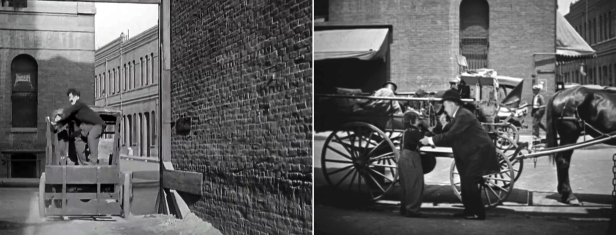
In his Chaplin book, Silent Traces, John describes the alley as being behind the Baker Building which used to be at 342 N Main Street, on the corner of Arcadia Street. Completed around 1877 by businessman Robert S. Baker, the large, three-story Baker Block was notable for its Napoleon III style towers, particularly its central bell-tower. It was reported to be the most expensive structure south of San Francisco, and believed to have been LA’s first steel-framed building.

By the early 20th century, the once-prestigious shopping and business center was losing its luster, and the Baker Building was purchased in 1919 by the nonprofit organization, Goodwill. Then, in 1941, the city purchased the entire block and demolished all the buildings a year later to accommodate a street extension. Today, Route 101’s “Downtown Slot” segment runs beneath where the Baker Building and alley from this scene once were.

Before being informed that this scene was filmed in Los Angeles, Blakeslee and I made several futile attempts to figure out this location, assuming it was somewhere in New York.
As Blakeslee researched an endless list of narrow streets and alleyways in Manhattan, I focused on the awning to the left of the alley which had the words, “Jewelry Co” on it. With not much to go on, I went to the NY Public Library on 42nd Street and looked through the directory of jewelers in 1925’s Manhattan yellow pages. Unfortunately, the list was quite voluminous and investigating every address seemed like a daunting task. I thought perhaps I could cross-reference each jewelry address with a list of plumber locations, since it appeared there was a plumber in the retail space to the right of the alley. But I couldn’t find any good leads.
Meanwhile, Blakeslee was becoming somewhat of an expert on New York alleys, but still hadn’t found anything that looked like the one in this scene. (Although, his alleyway knowledge proved useful a couple years later when trying to figure out some locations for Stanley Kubrick’s KIller’s Kiss.) A couple times we considered this scene was shot on a studio backlot, but ultimately discarded that theory. The buildings seen down the street opposite the alleyway looked rather authentic, and not like something created at a Hollywood studio. And as it turned out, we were correct about it being filmed on a real street, we just got the wrong city.

After John Bengtson helped me solve this location mystery, when I went to Google Maps I was initially disheartened when it looked like the entire area had been razed. But I was delighted to discover that the Garnier Building (est. 1890), part of which appeared in one shot from this scene, is still standing today. Once regarded as the unofficial “city hall” of Los Angeles’s Chinese community, the building has been home to the Chinese American Museum since 2003. Unfortunately, about one third of the structure (as well as the neighboring Jennette Building) had to get knocked down in the early 1950s to make way for the 101 highway, but it’s the one extant landmark that helped me pinpoint where this scene took place.


To better help me understand the geography of this scene, I consulted Bengtson’s book which listed other movies shot near that alleyway, including a 1924 Harry Langdon short called, Feet of Mud. In that film, you can see the rest of that jewelry shop inside the Arcadia Building, which sat next to the Baker Building and essentially helped create the alleyway. Turns out, that jeweler that eluded us for so long was called Plaza Jewelry Co., whose official address was 114 Aradia Street.
Going in the Subway

This is a location I almost immediately recognized, but ended up second-guessing myself. I was pretty sure the subway kiosk Jackie Coogan entered looked like the one at Astor Place, but I also knew that the kiosk that’s there today is only a replica. In 1925, there used to be many kiosks like the one in this scene throughout the city, so I began to think that it’d be a big coincidence that they just happened to film this scene at the one spot in the city that currently has a replica. Doubting myself, I wanted to be one hundred percent certain this scene took place at Astor Place.

After a little digging around, I found several vintage photos of the area, and saw enough similarities in and around the kiosk (including a gigantic eye-catching billboard) to feel fairly confident that Astor Place was where this scene was filmed. And while searching for photos of the original Astor Place kiosk, I stumbled upon several photos of other subway kiosks connected to the IRT’s eastside and westside lines.
These cast-iron entrances/exits for NYC’s original 1904 subway line were modeled after the ones used for Budapest, Hungary’s oldest subway line, which was constructed in 1896. These ornate structures that once lined the streets of Manhattan, were eventually taken down, starting in the 1950’s, because they were said to be blocking sight-lines for both pedestrians and motorists, causing accidents. By the late 60’s, all of these exotic-looking kiosks were replaced with the more ordinary staircases and railings that are familiar with subway riders today.
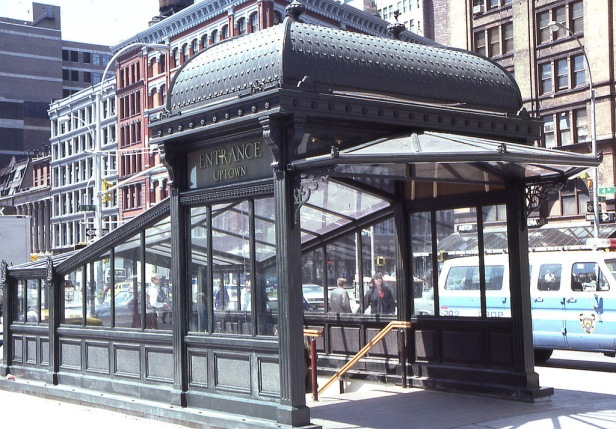
About 20 years after all the original kiosks were taken down, a replica of one was installed for the uptown 6 train at Astor Place on a traffic island just north of E 8th Street. (Its location probably chosen because of its unobtrusiveness to motor traffic.) Installed in March of 1986, this ornate recreation was designed using the initial 1904 IRT planning sheets.
While the original kiosk was featured in The Rag Man, the current replica was featured in the 1996 drama, Sleepers, in a scene that was supposed to be taking place in the summer of 1967. The filmmakers probably used this subway entrance because it had an authentic, old-fashioned look to it, but ironically, the subway kiosk would have been gone in 1967.
Exiting the Subway

I used basic deductive reasoning to figure out this location. I knew the mansion Kelly goes to was on the Upper East Side (see “Kelly Sells Junk” above), and since I could see there were large clusters of trees behind the subway stairs, I figured they were filming this quick scene somewhere next to Central Park. From there I just checked the map to see what subway entrances were near the east side of the Park, and the only one I found was for the 59th Street station for the BMT Broadway Line. A quick check in Google Street View and I was certain I found the right place.

Researching this film has been a long, but rewarding experience, and even though some of the “New York” exteriors were shot in Los Angeles (including the “fire” scene below which was shot on a studio backlot), The Rag Man still contains a lot more on-location footage of NYC than most films of the time. Fortunately, Blakeslee and I (along with help from John Bengtson) were able to find almost all of the locations.

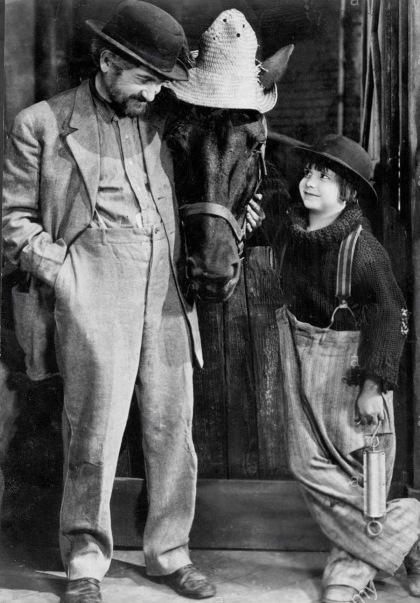 The only scene we couldn’t figure out was the one where Kelly talks to a young boy supposedly at 19 Park Avenue. The address given didn’t match with what used to be on that site in 1925, but that was somewhat expected as I was suspicious the scene was filmed on a backlot. Problem is I don’t have definitive proof one way or the other, so I will still have to consider it “unsolved.”
The only scene we couldn’t figure out was the one where Kelly talks to a young boy supposedly at 19 Park Avenue. The address given didn’t match with what used to be on that site in 1925, but that was somewhat expected as I was suspicious the scene was filmed on a backlot. Problem is I don’t have definitive proof one way or the other, so I will still have to consider it “unsolved.”
In the meanwhile, I will continue to search vintage photos of NYC, as well as vintage photos of old MGM backlots, in hopes of finding a matching building. But overall, I’m pretty satisfied the work Blakeslee and I have done.
It might be noted that there is potentially more research that can be done with another Jackie Coogan/Max Davidson movie. Turns out, the two actors reunited with director Edward Cline and teamed up with a young Joan Crawford to star in a sequel to Rag Man called, Old Clothes, released later the same year. Surprisingly, I wasn’t even aware there was a sequel to this film until after I began writing this post. There’s not much information about it out there, other than a cast list (that includes the return of the horse, ‘Dynamite’), a brief plot synopsis, and release date, so I don’t even know if it any of it was actually shot in New York City.
 According to a few sources, a print still exists today, but I haven’t seen a digital copy, nor have I heard of any modern screenings of the title. Somehow I doubt it will ever be readily available to the general public, so the chances of viewing it seem slim, but like an optimistic young Kelly, I can always hope.
According to a few sources, a print still exists today, but I haven’t seen a digital copy, nor have I heard of any modern screenings of the title. Somehow I doubt it will ever be readily available to the general public, so the chances of viewing it seem slim, but like an optimistic young Kelly, I can always hope.













Thank you so much Mark for your incredible detective work – this was simply brilliant.
LikeLiked by 1 person
SUPER-CLASSIC TREASURE OF ALL MOVIES… WISDOM-COMEDY THE RAG MAN (1925) with the irresistible charm that does Not exist in movies any longer…Smile&Cry throughout!!!
But they do NOT SELL DVDs, WHY???
LikeLiked by 1 person